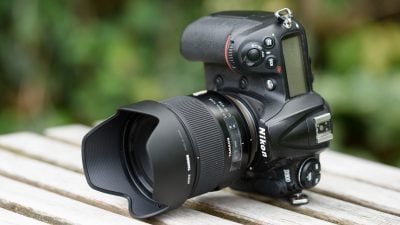Tamron 35mm f1.8 VC review
-
-
Written by Thomas
Quality
Longitudinal Chromatic Aberration and focus shift
With lenses offering an aperture of f2.8 or larger I test for longitudinal CA (loCA, a.k.a. “axial color” or “bokeh CA”). The new Tamron shows a clear magenta coloration in the foreground (left) and greenish hues in the background (right). This also shows up in real-life shots. By f5.6 the effect is gone. The test also revealed that there is some focus shift.
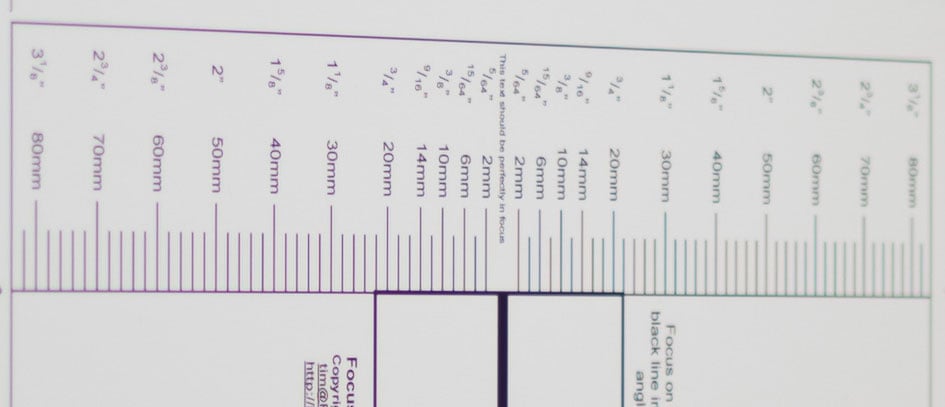
Above: Tamron 35/1.8 VC Longitudinal Chromatic Aberration (loCA) at f1.8. 100% crop, left = foreground, right = background
Sharpness and contrast
Let’s have a look at the theoretical performance of the new lens first compared to the performance of the Sigma 35mm f1.4 “Art”:
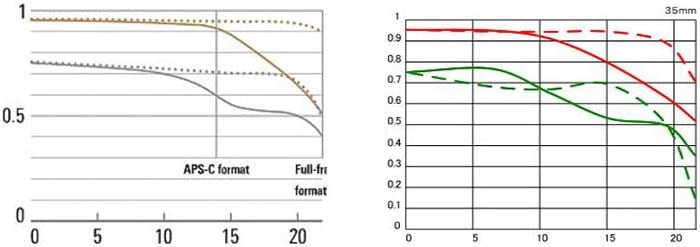
Above left: Tamron 35/1.8 VC MTF at f1.8, right: Sigma 35/1.4 Art MTF at f1.4
These charts show the lens-performance at the largest aperture. Higher values are better and the closer the dotted and the continuous lines of each color are together the less astigmatism (= resolution depends on the orientation of the test-pattern) the lens has. The x-axis displays the distance from the optical axis (=center of the sensor) in mm. I’ll show you the real-life performance at 4 mm (center), 13 mm (DX-corner), and 20 mm (FX-corner) on a D810.
From the charts, the new Tamron should perform quite similar to the Sigma. Both lenses show a clear drop in resolution (gray resp. green line) towards the corners of the APS-C/DX image-circle with another drop towards the corners of the FF/FX sensor where the Sigma looks worse than the Tamron – at least on paper. Remember though that the Tamron is shown here at f1.8 which is 2/3 of a stop darker than the Sigma at f1.4. But let’s see how this theoretical performance translates into real life results in the sharpness test based on Siemens-stars.
What follows are near-center results (first column) followed by APS-C/DX-corner results and FF/FX-corner results on a D810. The D810 results from the DX-corner should be a very good approximation for performance on a 16MP DX sensor (like the D7000), because the pixel-pitch of both sensors are the same. But differences in the AA-filter and micro-lens-design of a D810 and a D7000 might yield different end-results.
Processing was done in Lightroom 5.7.1 from RAW at Camera Standard settings. Noise-reduction is set to 0, sharpening to 35/0.5/36/10, with no extra tone, color, or saturation-adjustment. White-balance was adjusted to a neutral white and I did some exposure compensation to make the brightness match. CA-removal is ON.
The following are all 100% crops!
Tamron 35/1.8 VC; 100% crop from center, APS-C/DX-corner, FF/FX-corner

Above: 35mm, f1.8

Above: 35mm, f2.0

Above: 35mm, f2.8

Above: 35mm, f4.0

Above: 35mm, f5.6

Above: 35mm, f8.0

Above: 35mm, f11

Above: 35mm, f16
These 100% crops directly from a 36MP D810 sensor show that this lens delivers a very good performance at the center right from the start. To get the highest resolution in the center you need to over-shoot a bit (back-focus) which led to the magenta color-shift in the f1.8 and f2.0 crops. If you don’t back-focus you get a little less resolution in the center but the color-shift is gone and the lens exhibits no field-curvature. DX-corner and FX-corner show a little less contrast wide open with coma visible in the FX-corner. Coma is greatly reduced at f2.8 and from f4 onwards the lens is very sharp across the whole frame. Diffraction is clearly setting in at f11 and distortions are pretty low.
Following is the performance of the Tamron 35/1.8 VC at f2.0 (1st row) directly compared to the Sigma 35/1.4 Art (2nd row), the Nikon 35/1.8G (3rd row), and the Nikon 35/1.4G (last row) at f2.0. The three competitors were shot on a D800 with a slightly softening AA-filter and got a sharpening of 70/0.5/36/10 to make them comparable.

Above: Tamron 35/1.8 VC on Nikon D810 at 35mm, f2.0

Above: Sigma 35/1.4 Art on Nikon D800 at 35mm, f2.0

Above: Nikon 35/1.8G on Nikon D800 at 35mm, f2.0

Above: Nikon 35/1.4G on Nikon D800 at 35mm, f2.0
Compared to the Sigma 35/1.4 “Art” at f2.0 the Tamron shows the better results in the APS-C/DX-corner but is less well defined in the FF/FX-corner although the Sigma suffers from stronger coma. The Nikon 35/1.8G has a slight advantage in the APS-C/DX-corner over the Tamron but has the lowest overall contrast of the four lenses in the FF/FX-corner. The Nikon 35/1.4G is a bit softer in the center than the Tamron and shows similar corners.
Performance at long distances
The Siemens-star test-targets are shot at a distance of 40x focal length (i.e. at 1.4m for 35mm focal length). But performance of lenses also depends on the shooting distance. Therefore I present another series of test-shots of a landscape dubbed the “Unremarkables” where you can measure distances in km, not meter. Processing was done in Lightroom 5.7.1 from RAW at Adobe Standard settings. Noise-reduction is set to 0, sharpening to 35/0.5/36/10, with no extra tone, or saturation-adjustment. There’s no tinkering with vignette-control so you see it here as it is produced by the lens. Focus was acquired at the largest aperture manually and not changed for other apertures.
You can click on each image to access the large original. Please respect our copyright and only use those images for personal use.
The main image shows the complete scene at f1.8 to give you an impression of the angle of view and to judge vignetting. This is followed by one row of 100% crops at different apertures each from near the middle, the DX/APS-C-corner, and the FX/FF-corner. You can access the respective shots up to f16 via the links beneath the main image.
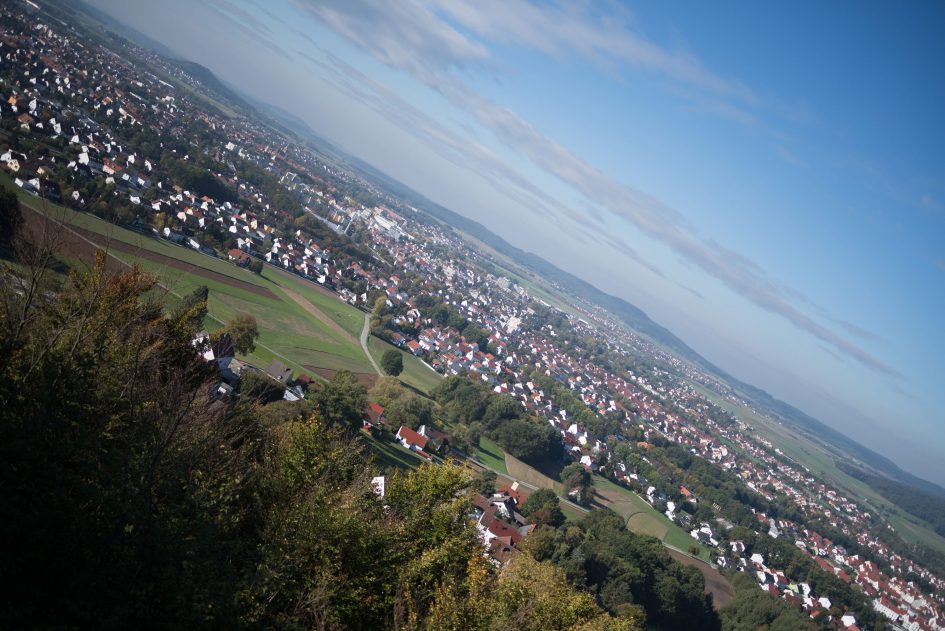
Above: Tamron 35/1.8 VC at f1.8; also available at f2.0, f2.8, f4.0, f5.6, f8.0, f11, f16

Above: Tamron 35/1.8 VC at f1.8; 100% crop from center, APS-C/DX-corner, FF/FX-corner

Above: Tamron 35/1.8 VC at f2.8; 100% crop from center, APS-C/DX-corner, FF/FX-corner

Above: Tamron 35/1.8 VC at f4.0; 100% crop from center, APS-C/DX-corner, FF/FX-corner

Above: Tamron 35/1.8 VC at f5.6; 100% crop from center, APS-C/DX-corner, FF/FX-corner

Above: Tamron 35/1.8 VC at f8.0; 100% crop from center, APS-C/DX-corner, FF/FX-corner
Performance wide open is pretty impressive especially in the FF/FX-corner which is only suffering a bit from the haze around bright areas resulting from coma. But stop down to f2.8 and that cleans up nicely. Only the APS-C/DX-corner doesn’t become as crisp as the center.
Following is a comparison at f2.0 with the Nikon 35/1.8G (2nd row) and the Nikon 35/1.4G (3rd row). Both shots from the Nikons were made last year in February on a D800. Thus atmospheric conditions were not the same. For the comparison I adapted white-balance and exposure in post-processing but did not touch contrast. The images with the Tamron on the D810 (which has no AA-filter) were sharpened at 35/0.5/36/10 while the shots from both Nikons on the D800 (with AA-filter) were sharpened at 70/0.5/36/10. So although not exactly comparable the crops should give you a good impression of how those lenses compare.

Above: Tamron 35/1.8 VC at f2.0; 100% crop from center, APS-C/DX-corner, FF/FX-corner

Above: Nikon 35/1.8G at f2.0; 100% crop from center, APS-C/DX-corner, FF/FX-corner

Above: Nikon 35/1.4G at f2.0; 100% crop from center, APS-C/DX-corner, FF/FX-corner
The Nikon 35/1.8G performs pretty similar to the Tamron with the Nikon offering a bit better APS-C/DX-corner but a weaker FF/FX-corner due to stronger coma. The Nikon 35/1.4G has a very sharp center but lags both other lenses in the APS-C/DX-corner and the FF/FX-corner.
All-in-all the new Tamron 35/1.8 VC is a very good performer near and far with a slight weakness at the border of the APS-C/DX image circle at long-distance shots. Field curvature is negligible. Distortions and vignetting are pretty moderate.
Rendering of point-light sources at night-shots
Night-shots pose a different challenge for lenses as the contrast is even higher than under bright sun and point-light sources can reveal some weaknesses such as coma, haloing and color-aberrations that do not show up as prominently in other test-shots. The 100% crops below the main image show the effect of coma in the FX corner of this lens at various apertures. From f4.0 the effect is negligible:
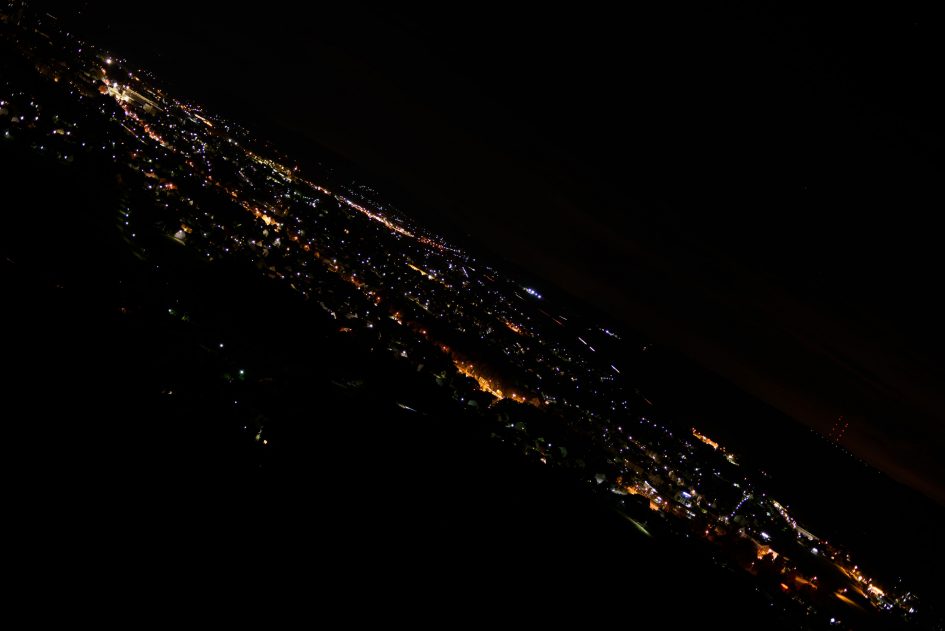
Above: Tamron 35/1.8 VC at f1.8; also available at f2.0, f2.8, f4.0, f5.6

Above: Tamron 35/1.8 VC; 100% crop from FF/FX corner at f1.8, f2.8, f4.0
Unfortunately some CA show up none-the-less in the form of blue/magenta halos around point-lights at f1.8. This effect is visibly reduced already at f2.0 and gone at f2.8 as the following crops from the center show:

Above: Tamron 35/1.8 VC; 100% crop from center at f1.8, f2.0, f2.8
I think this effect is due to longitudinal CA and can be reduced by pulling focus a bit more towards the camera. But that would compromise optimal sharpness. Following is another 100% crop from a typical situation where this “magenta ghosting” raises its ugly head.

Above: Tamron 35/1.8 VC at f1.8; 100% crop from center
Rendering of out-of-focus point-light sources
This test is for the rendering of point-light sources in an out-of-focus background. The circle of confusion that is produced by this test is pretty indicative of Bokeh performance (in the background) and light fall-off. Ideally the out-of-focus image of the point-light is evenly lit and perfectly circular, with no “onion-rings”, and without coloration. Large aperture lenses normally produce an effect known as “cat’s eye” the further away from the optical axis the point-light is projected. This is due to optical vignetting in the lens barrel when light enters the lens from an angle.
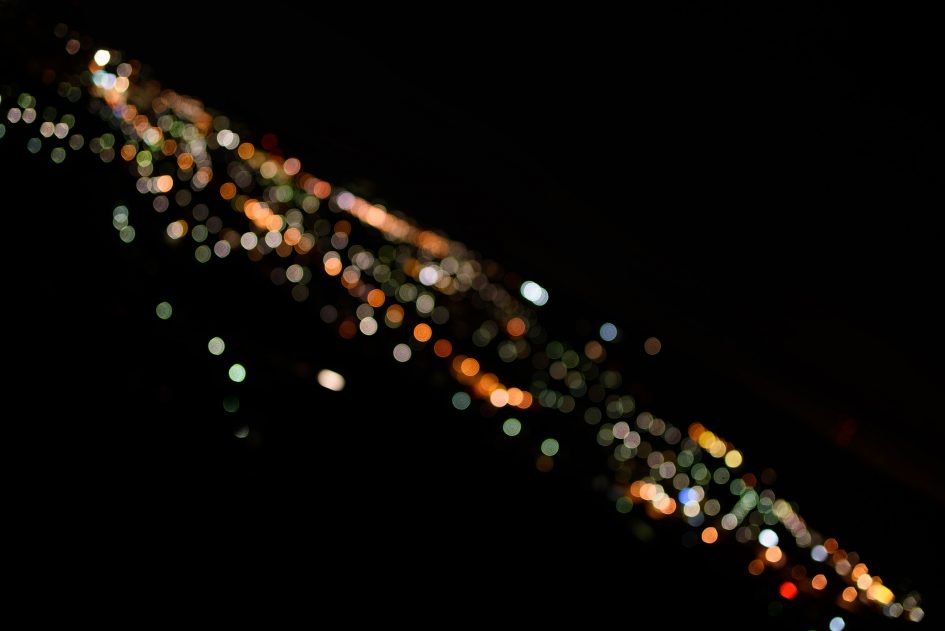
Above: Tamron 35/1.8 VC at f1.8; also available at f2.0, f2.8, f4.0, f5.6

Above: Tamron 35/1.8 VC at f1.8; 50% crop from center, APS-C/DX-corner, FF/FX-corner
As the 50% crops above show: The Tamron 35/1.8 VC produces only a small circle of confusion. It exhibits onion rings and an uneven light-distribution across the circle with a green outline which stems from the longitudinal CA of this lens. The cat’s-eye effect towards the borders/corners of the sensor is pretty moderate and there is no clipping from the mirror-box.
Now let’s see how this analysis of out-of-focus point-light sources translates into Bokeh-performance shooting a book-shelf.
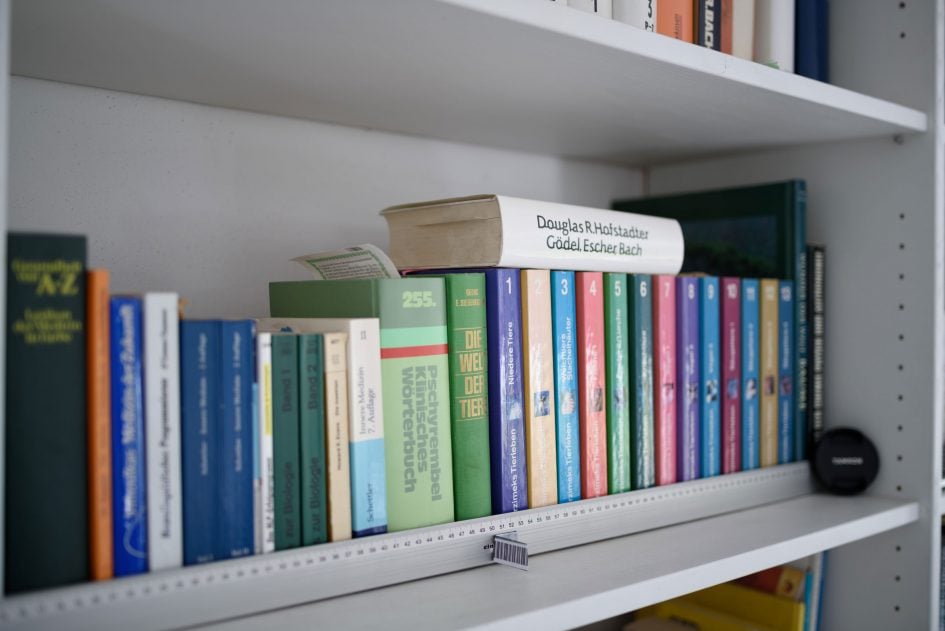
Above: Tamron 35/1.8 VC at f1.8; also available at f2.0, f2.8, f4.0, f5.6

Above: Tamron 35/1.8 VC at f1.8; 50% crop from foreground, middle-ground, background
While the (less important) foreground is nicely blurred, the middle ground suffers from longitudinal CA coloring the black letters green. The lens even introduces some magenta color inside the “e” of “Hofstadter”. The background shows outlining which makes the Bokeh nervous.
Flare/ghosting
Catching a strong light-source shining directly into the lens is a real risk with wide-angle lenses – even with the lens-hood attached. That could produce strange colorful ghosts-images or reduce contrast considerably through flare and glare. The appearance of flare and ghosting depends on factors like the aperture and the angle of the light hitting the lens. So to judge the proclivity of the Tamron for these artifacts I went through a series of well calculated shots against a strong light source to provoke glare and ghosting.
The results are pretty good: As long as the light was clearly outside the image-frame I found no artifacts – although the light was shining directly into the lens. When the light was near the image corner but still outside the frame it provoked a flare:
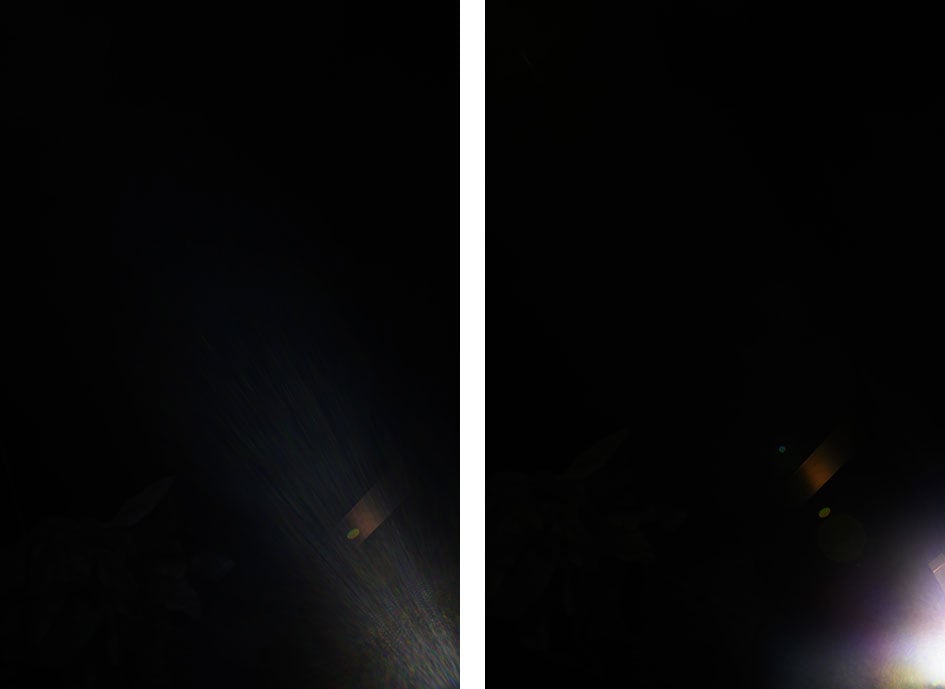
Above: Strong light hitting the Tamron 35/1.8 VC from the corner of the FF/FX image frame at f8.0
So you have to watch out a bit for strong light-sources directly outside the frame. But other than that the flare-resistance of this lens is good. The following image shows the amount of ghosting that you can provoke:
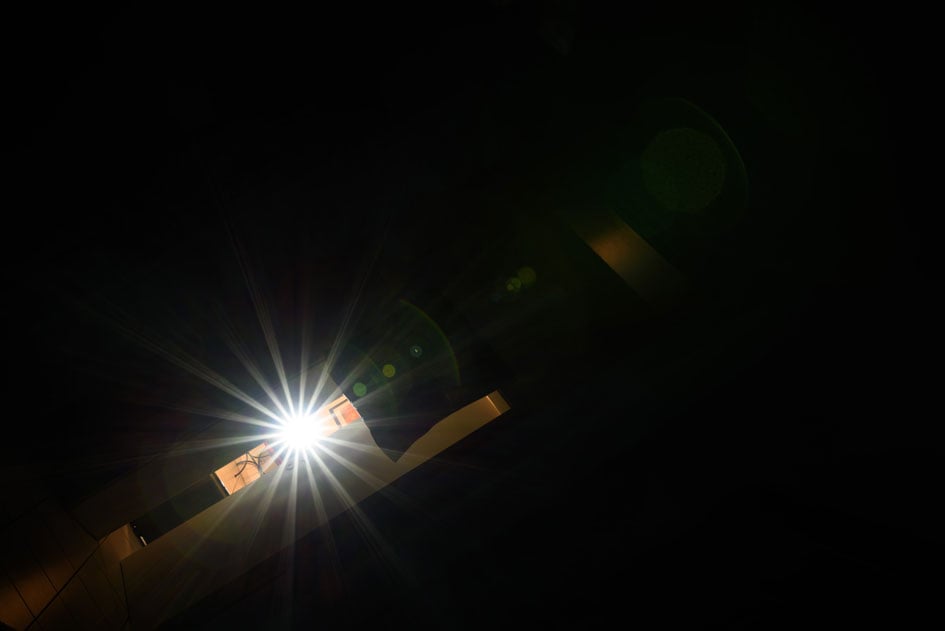
Above: Strong light hitting the Tamron 35/1.8 VC at f8.0
Considering the extreme test-conditions ghosting is pretty moderate.




